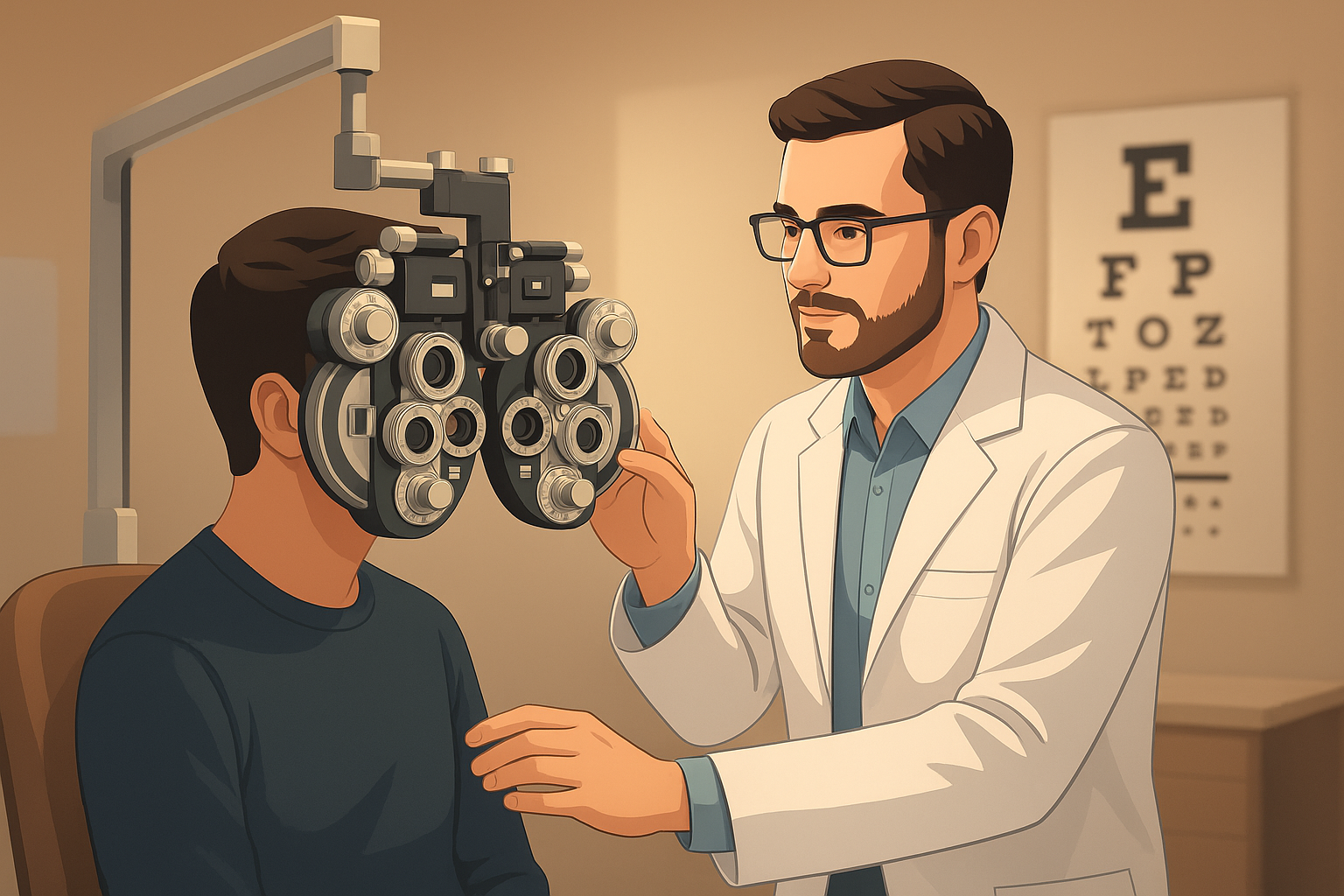Introduction
Regular eye exams are not just about updating your prescription for glasses or contact lenses. They are an essential part of maintaining your overall health and preventing vision-threatening conditions. Many eye diseases—such as glaucoma, diabetic retinopathy, and macular degeneration—develop silently without obvious symptoms until significant damage has occurred.
But how often should you schedule an eye exam? The answer depends on your age, risk factors, and whether you already wear corrective lenses. In this guide, we’ll break down the recommended eye exam schedule by age group, highlight key risk factors that may require more frequent checkups, and provide practical tips for maintaining lifelong vision health.
Why Eye Exams Are Important
- Early Detection of Eye Diseases: Conditions like glaucoma often cause irreversible damage before symptoms appear. Regular exams catch them early.
- Overall Health Screening: Eye exams can reveal signs of systemic health issues such as diabetes, high blood pressure, autoimmune diseases, and even certain cancers.
- Vision Correction: Ensures your glasses or contact lens prescription is up to date, reducing eye strain and headaches.
- Preventive Care: Regular monitoring helps prevent long-term complications.
👉 The Role of Sleep in Maintaining Eye Health: Why Rest is Essential for Vision
Eye Exam Frequency by Age Group
Infants and Toddlers (0–2 years)
- First eye exam recommended at 6–12 months
- Pediatricians often check eye alignment, focus, and basic visual responses
- Early detection is critical for conditions like lazy eye (amblyopia) and strabismus
Children and Adolescents (3–17 years)
- Ages 3–5: At least one comprehensive eye exam before school starts
- Ages 6–17: Every 1–2 years, unless symptoms like squinting, sitting too close to the TV, or poor school performance suggest vision problems
Note: Uncorrected vision problems in children can affect learning and development.
👉 Preventing Vision Loss: Comprehensive Guide to Protecting Your Eyesight Naturally
Adults 18–39 years
- If healthy: Every 2 years
- If wearing glasses or contact lenses: Annually
- Risk factors like diabetes, high blood pressure, or family history of eye disease require yearly exams
Adults 40–64 years
- Comprehensive exam every 1–2 years
- This is the age when early signs of presbyopia (difficulty reading up close) and age-related eye conditions begin to appear
- Screening for glaucoma and macular degeneration should start
Seniors 65+ years
- Eye exams annually
- High risk for cataracts, macular degeneration, glaucoma, and diabetic retinopathy
- Early intervention is key to maintaining independence and quality of life
👉 Eye Care for All Ages: Essential Tips for Lifelong Vision Health
Risk Factors That Require More Frequent Eye Exams
- Diabetes – increases risk of diabetic retinopathy
- High blood pressure or high cholesterol – can damage retinal blood vessels
- Family history of eye disease – especially glaucoma or AMD
- Previous eye surgery or trauma
- Occupational hazards – jobs with eye strain, bright lights, or hazardous materials
- Frequent screen use – digital eye strain and dry eye syndrome
If you have one or more of these risk factors, schedule annual or semi-annual exams even if you don’t notice symptoms.
Types of Eye Exams
- Visual Acuity Test – Measures sharpness of vision
- Refraction Test – Determines prescription for glasses or contacts
- Slit-Lamp Examination – Checks cornea, iris, and lens for abnormalities
- Tonometry – Measures intraocular pressure for glaucoma detection
- Dilated Fundus Exam – Examines retina and optic nerve
- OCT (Optical Coherence Tomography) – Provides detailed imaging of the retina
What to Expect at Your Eye Exam
- Review of medical and family history
- Discussion of symptoms such as blurred vision, floaters, headaches, or night vision problems
- Vision and eye health tests based on age and risk profile
- Personalized recommendations for eyewear, lifestyle changes, or further tests
Tips to Maximize the Benefits of Eye Exams
- Bring a list of current medications (some affect vision)
- Note any vision changes, even if minor
- If you wear glasses or contacts, bring them to the exam
- Ask your eye doctor about blue light protection, UV-blocking lenses, or supplements for eye health
👉 The 5 Most Common Eye Problems and How to Prevent Them
Eye Exam Frequency Quick Reference Table
| Age Group | No Risk Factors | With Risk Factors |
|---|---|---|
| Infants (0–2) | 6–12 months | As advised by pediatrician |
| Children (3–17) | Every 1–2 years | Annually |
| Adults (18–39) | Every 2 years | Annually |
| Adults (40–64) | Every 1–2 years | Annually |
| Seniors (65+) | Annually | Annually |
❓ FAQ – Eye Exam Frequency
👉 How often should children get an eye exam?
Children should have their first comprehensive eye exam at 6–12 months, then again at age 3, before starting school, and every 1–2 years afterward.
👉 How often do adults need an eye exam?
Adults aged 18–39 should have an eye exam every 2 years, while those aged 40–64 should go every 1–2 years. After age 65, annual eye exams are recommended.
👉 Do people with glasses or contact lenses need more frequent exams?
Yes. Anyone with refractive errors (myopia, hyperopia, astigmatism, or presbyopia) should have an annual exam to monitor changes in vision.
👉 How often should diabetics get an eye exam?
People with diabetes should have a comprehensive dilated eye exam at least once a year, since they are at higher risk for diabetic retinopathy.
👉 Is it necessary to get an eye exam if I have no symptoms?
Yes. Many eye diseases, including glaucoma and macular degeneration, develop without early symptoms. Regular exams help detect them before vision loss occurs.
Conclusion
Regular eye exams are essential for maintaining good vision and overall health. The frequency of exams depends on age, lifestyle, and medical history.
- Children need exams to support healthy learning and development.
- Adults should stay proactive in their 20s and 30s to catch early signs of eye strain and refractive errors.
- Middle-aged adults must begin monitoring for age-related diseases.
- Seniors require yearly exams to prevent serious vision loss.
By following these guidelines and consulting with your optometrist or ophthalmologist, you can protect your eyesight for a lifetime.
Recommended Products for Regular Eye Care
👉 Stay proactive about your vision health.
- At-Home Vision Test Kit – Track your vision between eye doctor visits.
- Eye Health Supplements (Lutein, Zeaxanthin, Omega-3) – Protect and support long-term eye health.
- Contact Lens Care Kit – Keep your eyes safe with trusted solutions and hygiene products.
- Computer Glasses – Reduce eye strain from screens and prevent headaches.
- Lubricating Eye Drops – Quick relief for dryness and irritation.


